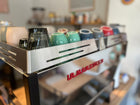More about Brazil Fazenda do Cruzeiro Anaerobic
Description
More
Less
This coffee comes from producer Ivan Junqueira Ribeiro, owner of Fazenda Cruzeiro, a farm in Brazil's Campo das Vertentes region. The farm was established in 1923 and spans a total of 1,021 hectares, of which 381 are planted with Red Catuai, Yellow Bourbon, Mundo Novo, Topázio, Arara, and Rubi.
The cherries of this remarkable coffee are picked ripe, using both mechanical and manual harvesting techniques. After harvesting, the cherries are moved to a cement patio, where the drying process begins.
Each coffee bean that comes out of this farm carries the soul and the hard work of the coffee grower and each cup of coffee is an expression of its unique terroir.
Country and Region Mundo Novo, Rubi (microlot)
More
Less
Process: Yeast-Inoculated Anaerobic Natural
More
Less
Variety: Mundo Novo, Rubi (microlot)
More
Less
Description
This coffee comes from producer Ivan Junqueira Ribeiro, owner of Fazenda Cruzeiro, a farm in Brazil's Campo das Vertentes region. The farm was established in 1923 and spans a total of 1,021 hectares, of which 381 are planted with Red Catuai, Yellow Bourbon, Mundo Novo, Topázio, Arara, and Rubi.
The cherries of this remarkable coffee are picked ripe, using both mechanical and manual harvesting techniques. After harvesting, the cherries are moved to a cement patio, where the drying process begins.
Each coffee bean that comes out of this farm carries the soul and the hard work of the coffee grower and each cup of coffee is an expression of its unique terroir.
Country and Region Mundo Novo, Rubi (microlot)
Process: Yeast-Inoculated Anaerobic Natural
Variety: Mundo Novo, Rubi (microlot)
You May Also Like
More about us on social media















